
|
Now it is 6.3 mag (Jan. 30, Piotr Guzik). It keeps bright as 7 mag and observable in excellent condition until April. Then it will be fading and will be unobservable in June. In the Southern Hemisphere, it is not observable now. It will be observable in the evening low sky from April to June.
Date(TT) R.A. (2000) Decl. Delta r Elong. m1 Best Time(A, h)
Feb. 11 17 1.46 48 52.5 1.421 1.692 87 6.4 3:56 (214, -8)
Feb. 18 16 40.84 55 5.1 1.347 1.732 94 6.4 4:05 (203, -7)
|

|
Now it is very bright as 8.8 mag (Jan. 10, Juan Jose Gonzalez). It will keep 10 mag until March, but it will be too low to observe. It is already unobservable in the Southern Hemisphere.
Date(TT) R.A. (2000) Decl. Delta r Elong. m1 Best Time(A, h)
Feb. 11 23 2.48 -3 30.0 1.850 1.031 24 10.3 20:31 ( 80, -8)
Feb. 18 23 33.21 -2 59.2 1.854 1.034 24 10.3 20:21 ( 82, -6)
|
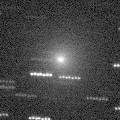
|
New comet discovered on Feb. 11. It is very bright as 10.6 mag (Feb. 12, A. Novichonok, V. Gerke). It has approached to the earth down to 0.2 A.U. in late January. Then it must have been bright as 10 mag and located in excellent position. It will approach to the sun down to 0.8 A.U. in mid March. In the Northern Hemisphere, it keeps observable at 11 mag until mid March, although it will be getting lower in the evening sky. In the Southern Hemisphere, it is already very low, and will be unobservable soon. After the perihelion passage, it will appear in the morning sky at 15 mag in May, then it keeps observable while fading.
Date(TT) R.A. (2000) Decl. Delta r Elong. m1 Best Time(A, h)
Feb. 11 2 0.67 18 15.3 0.588 0.990 73 11.3 20:31 (123, 13)
Feb. 18 1 36.13 17 17.6 0.825 0.921 60 11.5 20:21 (116, 6)
|

|
It was observed as bright as 13.9 mag in 2011 autumn (Oct. 19, Hidetaka Sato). It is not observable now. In the Northern Hemisphere, it will be observable again in 2012 summer, when it will be fainter than 15 mag. In the Southern Hemisphere, it will never be observable again.
Date(TT) R.A. (2000) Decl. Delta r Elong. m1 Best Time(A, h)
Feb. 11 21 40.91 4 16.6 2.287 1.389 18 11.9 20:31 ( 74,-29)
Feb. 18 22 2.39 7 49.3 2.306 1.417 19 12.0 4:05 (283,-31)
|

|
Now it is very bright as 11.0 mag (Feb. 10, Uwe Pilz). In the Northern Hemisphere, it keeps observable at 11-12 mag in good condition until March, but it will be unobservable in April. In the Southern Hemisphere, it will be low in the evening sky after this.
Date(TT) R.A. (2000) Decl. Delta r Elong. m1 Best Time(A, h)
Feb. 11 1 49.82 8 42.4 2.190 2.023 67 12.6 20:31 (115, 18)
Feb. 18 2 4.10 9 49.1 2.264 2.030 63 12.6 20:21 (115, 16)
|
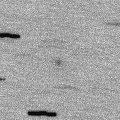
|
A comet discovered from the SOHO spacecraft images in 2003 was rediscovered from the STEREO spacecraft images. Hidetaka Sato reported it is bright as 15.1 mag (Feb. 3). It may be visible visually. It will be fading gradually, but getting higher after this. It locates very low in the Southern Hemisphere.
Date(TT) R.A. (2000) Decl. Delta r Elong. m1 Best Time(A, h)
Feb. 11 0 14.45 -7 5.8 0.925 0.651 39 13.0 20:31 ( 88, 9)
Feb. 18 1 3.78 -3 41.4 0.851 0.723 45 13.5 20:21 ( 95, 13)
|

|
It reached up to 9.7 mag with a large bright coma in autumn (Oct. 29, Juan Jose Gonzalez). It will be fading after this. Outburst occured on Jan. 2, but it has been already diffuse and fading. Nowever, it is very bright still now as 10.8 mag (Jan. 20, Marco Goiato). It keeps high for a while, but it will be getting lower after February. It will be unobservable in late March in the Northern Hemisphere, or late April in the Southern Hemisphere.
Date(TT) R.A. (2000) Decl. Delta r Elong. m1 Best Time(A, h)
Feb. 11 2 53.63 -4 56.9 2.758 2.741 78 13.3 20:31 (115, 39)
Feb. 18 2 55.99 -5 35.4 2.928 2.795 72 13.5 20:21 (111, 36)
|

|
It brightened up to 17.1 mag in late June in 2011 (June 24, J. F. Hernandez). The condition of this apparition is bad, and it is not observable around the perihelion passage. It will appear in the morning sky at 14 mag in pril in the Southern Hemisphere. It will not be observable until June in the Northern Hemisphere, when the comet will be 15.5 mag.
Date(TT) R.A. (2000) Decl. Delta r Elong. m1 Best Time(A, h)
Feb. 11 20 52.68 -23 6.3 2.605 1.661 13 13.3 3:56 (302, -5)
Feb. 18 21 13.45 -21 54.4 2.615 1.683 15 13.4 4:05 (299, -3)
|

|
Now it is bright as 13.5 mag and visible visually (Jan. 20, Chris Wyatt). It keeps bright as 13-14 mag for a long time after this until 2013. It is not observable in the Northern Hemisphere, but it is observable in good condition in the Southern Hemisphere.
Date(TT) R.A. (2000) Decl. Delta r Elong. m1 Best Time(A, h)
Feb. 11 1 47.57 -75 21.5 5.730 5.463 69 13.5 20:31 ( 17, 41)
Feb. 18 1 58.73 -73 33.8 5.724 5.466 70 13.5 20:21 ( 20, 41)
|
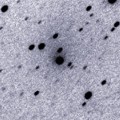
|
It was 14.2 mag and strongly condensed on Jan. 3 (Juan Jose Gonzalez). Recent total magnitude is uncertain.
Date(TT) R.A. (2000) Decl. Delta r Elong. m1 Best Time(A, h)
Feb. 11 12 38.80 -13 27.2 5.620 6.261 126 13.7 3:18 (180, 69)
Feb. 18 12 37.26 -13 29.2 5.533 6.261 134 13.7 2:49 (180, 69)
|

|
Big asteroid discovered in 1906. It suddenly showed the cometary activity on Dec. 11, 2010, probably due to an impact of a small object. It was very bright as 11.5 mag visually (Dec. 17, 2010, Juan Jose Gonzalez). Now it is 14.1 mag (Jan. 3, Hidetaka Sato). It has already turned to be stellar.
Date(TT) R.A. (2000) Decl. Delta r Elong. m1 Best Time(A, h)
Feb. 11 16 11.55 -13 28.0 2.490 2.483 78 13.9 3:56 (252, 45)
Feb. 18 16 20.57 -14 0.9 2.398 2.478 82 13.9 4:05 (247, 51)
|

|
It brightened up to 14.1 mag in August and September (Aug. 11, Artyom Novichonok and Vladimir Gerke). Now it is not observable. It will appear in the morning sky at 14 mag at the end of February. Then it will be observable in good condition in the Southern Hemisphere while fading gradually. It will locate somewhat low in the Northern Hemisphere. In 2011, some visual observers reported it was very bright as 10-12 mag.
Date(TT) R.A. (2000) Decl. Delta r Elong. m1 Best Time(A, h)
Feb. 11 19 57.79 -15 3.6 3.302 2.430 23 13.9 3:56 (288, 0)
Feb. 18 20 12.63 -15 2.4 3.291 2.451 26 13.9 4:05 (285, 5)
|
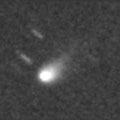
|
It is expected to be bright as 9 mag from 2012 to 2013. Now it is 13.9 mag and visible visually (Jan. 27, Jakub Cerny). In the Northern Hemisphere, it keeps observable in good condition for a long time until 2012 autumn when the comet brightens up to 10 mag. In the Southern Hemisphere, it is hardly observble before the perihelion passage. But it becomes observable in good condition since 2013 after the perihelion passage.
Date(TT) R.A. (2000) Decl. Delta r Elong. m1 Best Time(A, h)
Feb. 11 15 33.75 48 2.3 3.906 4.206 100 14.2 3:56 (202, 2)
Feb. 18 15 37.82 48 58.9 3.806 4.143 103 14.1 4:05 (197, 3)
|

|
It was already visible visually at 14.3 mag in 2011 (Oct. 1, Jakub Cerny). Although it has been unobservable for a while, it is appearing in the morning sky now. It keeps 13-14 mag and observable in good condition until September.
Date(TT) R.A. (2000) Decl. Delta r Elong. m1 Best Time(A, h)
Feb. 11 18 14.31 -14 11.6 5.754 5.155 48 14.1 3:56 (273, 21)
Feb. 18 18 14.49 -14 8.9 5.645 5.150 55 14.1 4:05 (268, 28)
|

|
It was expected to keep 14-15 mag for a long time from 2011 summer to 2012 summer. However, it is lost. It was observed only during two days in 2010 June. So the orbital elements are extremely uncertain. The condition is good in the Southern Hemisphere. But in the Northern Hemisphere, it is not observable until August.
Date(TT) R.A. (2000) Decl. Delta r Elong. m1 Best Time(A, h)
Feb. 11 0 27.78 -62 54.5 2.680 2.299 57 14.3 20:31 ( 33, 35)
Feb. 18 0 59.11 -59 47.9 2.671 2.302 57 14.3 20:21 ( 38, 36)
|

|
New Kreutz sungrazer comet discovered on the ground after 41-year blank since Comet C/1970 K1 (White-Ortiz-Bolelli). It approached nearly to the surface of the Sun on Dec. 16, and reached -4 mag or brighter at best. Then it appeared in the morning sky in the Southern Hemisphere, and it became a great comet with a bright long tail of 30-40 degrees. Now it is 12.0 mag (Jan. 27, Alan Hale). However, the nucleus of the comet is not visible at all, fainter than 19 mag (Jan. 2, Robert McNaught). Probably the comet itself has already disappeared and only the remnant is visible. The tail became extremely faint, but the very long tail of 20-30 degrees is detectable by photos still now with an excellent sky condition. Now it is observable also in the Northern Hemisphere.
Date(TT) R.A. (2000) Decl. Delta r Elong. m1 Best Time(A, h)
Feb. 11 4 49.66 -26 23.0 1.131 1.620 99 14.4 20:31 (118, 73)
Feb. 18 4 54.60 -21 36.3 1.324 1.750 97 15.3 20:21 (124, 68)
|

|
Now it is visible visually at 14.3 mag (Jan. 20, Sandor Szabo). It is expected to be 13 mag and will be observable in good condition in 2013. In the Northern Hemisphere, it keeps observable for a long time after this. It is not observable in the Southern Hemisphere.
Date(TT) R.A. (2000) Decl. Delta r Elong. m1 Best Time(A, h)
Feb. 11 23 2.98 49 11.4 7.070 6.736 66 14.7 20:31 (130,-34)
Feb. 18 23 5.44 48 51.7 7.114 6.713 62 14.7 20:21 (129,-36)
|

|
Now it is 15.0 mag (Jan. 17, Yasukazu Ikari). It is getting lower in the evening sky. It will be unobservable soon in the Northern Hemisphere, or in mid March in the Southern Hemisphere. It is expected to be observable at 13 mag for a long time from 2012 summer to 2013 summer. It will be observable in excellent condition in the Southern Hemisphere. But it is not observable at brightest time in the Northern Hemisphere.
Date(TT) R.A. (2000) Decl. Delta r Elong. m1 Best Time(A, h)
Feb. 11 1 5.78 -32 48.4 4.049 3.513 51 15.0 20:31 ( 70, 31)
Feb. 18 1 8.01 -32 32.1 4.052 3.455 47 14.9 20:21 ( 68, 28)
|

|
First return of a new comet which brightened up to 9.5 mag in a major outburst in 2006. It was recovered on Dec. 17, but much fainter than expected. However, it looks very diffuse, and the total magnitude was bright as 13.5 mag (Dec. 26, Michael Jager). It is still bright as 15.9 mag (Jan. 25, Yasukazu Ikari). It may be visible visually. It approached to the earth down to 0.24 A.U. in late January. It will keep close to the earth and observable in good condition in the evening sky for a while after this. However, it may fade out very rapidly after this.
Date(TT) R.A. (2000) Decl. Delta r Elong. m1 Best Time(A, h)
Feb. 11 4 46.54 -19 1.9 0.274 1.075 101 15.4 20:31 (133, 69)
Feb. 18 5 33.24 -22 37.2 0.310 1.112 105 16.3 20:21 (144, 75)
|

|
Now it is bright as 15.6 mag (Jan. 13, Toshiyuki Takahashi). Although it was extremely faint as 20.5 mag at the recovery in 2010 autumn, it brightened rapidly. It will keep 15 mag and observable in good condition for a long time from 2012 to 2013. But it locates somewhat low in the Northern Hemisphere in 2013.
Date(TT) R.A. (2000) Decl. Delta r Elong. m1 Best Time(A, h)
Feb. 11 13 37.04 10 19.9 2.782 3.397 121 15.7 3:56 (187, 44)
Feb. 18 13 37.66 10 47.5 2.687 3.380 127 15.6 3:49 (180, 44)
|

|
Now it is 16.0 mag (Jan. 18, Toshiyuki Takahashi). In the Northern Hemisphere, it keeps observable at 14-15 mag in good condition until early 2013. In the Southern Hemisphere, it is not observable until late 2012.
Date(TT) R.A. (2000) Decl. Delta r Elong. m1 Best Time(A, h)
Feb. 11 19 37.23 27 56.1 3.346 2.832 51 15.8 3:56 (249,-19)
Feb. 18 19 44.96 30 15.7 3.251 2.782 53 15.7 4:05 (243,-15)
|
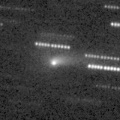
|
It reached up to 11-12 mag in 2011 autumn. Now it is fading. It has already faded down to 16.2 mag (Jan. 17, A. Diepvens). But it has a very long tail. It keeps observable in good condition until May when it becomes fainter than 18 mag. It locates somewhat low in the Southern Hemisphere.
Date(TT) R.A. (2000) Decl. Delta r Elong. m1 Best Time(A, h)
Feb. 11 12 31.78 22 17.7 1.028 1.878 137 15.8 3:11 (180, 33)
Feb. 18 12 29.68 24 25.6 1.039 1.923 143 15.9 2:41 (180, 31)
|

|
In the Southern Hemisphere, it is appearing int he morning sky. It will be observable at 15-16 mag in good condition for a long time until 2013 summer. It is not observable at all in the Northern Hemisphere.
Date(TT) R.A. (2000) Decl. Delta r Elong. m1 Best Time(A, h)
Feb. 11 19 6.67 -39 7.7 4.917 4.221 40 16.2 3:56 (303, 23)
Feb. 18 19 14.72 -40 5.6 4.819 4.199 46 16.1 4:05 (301, 28)
|
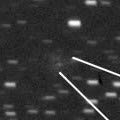
|
It is expected to be a great comet of 0 mag in 2013 spring. Now it is 16.3 mag (Jan. 13, Toshiyuki Takahashi), brightening well. In 2012, it keeps observable until summer while brightening gradually. It locates somewhat low in the Northern Hemisphere.
Date(TT) R.A. (2000) Decl. Delta r Elong. m1 Best Time(A, h)
Feb. 11 16 54.58 -23 0.3 5.940 5.620 66 16.4 3:56 (271, 41)
Feb. 18 16 56.90 -23 14.3 5.757 5.550 73 16.2 4:05 (266, 49)
|

|
It is bright as 16.1 mag still now (Jan. 23, Hidetaka Sato). After a small outburst in early December, it keeps its brightness without fading. It will keep 16 mag some more time. It is observable in good condition in the Southern Hemipshere. It keeps locating very low in the Northern Hemisphere.
Date(TT) R.A. (2000) Decl. Delta r Elong. m1 Best Time(A, h)
Feb. 11 15 10.54 -38 7.7 1.735 1.935 85 16.8 3:56 (286, 67)
Feb. 18 15 16.33 -39 14.6 1.730 2.011 91 16.9 4:05 (291, 73)
|
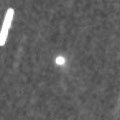
|
Now it is 17.2 mag (Jan. 17, M. Caimmi). In the Northern Hemisphere, it keeps observable at 16-17 mag in good condition for a long time from 2012 to 2013. It is not observable in the Southern Hemisphere.
Date(TT) R.A. (2000) Decl. Delta r Elong. m1 Best Time(A, h)
Feb. 11 12 35.79 52 17.0 3.601 4.278 127 17.1 3:15 (180, 3)
Feb. 18 12 26.26 54 57.8 3.556 4.245 128 17.0 2:38 (180, 0)
|

|
It is expected to keep 13 mag and observable in good condition in the Northern Hemisphere for a long time from 2013 to 2014. Now it is 17.6 mag (Jan. 23, Catalina Sky Survey). It keeps observable at 17-18 mag in good condition until June.
Date(TT) R.A. (2000) Decl. Delta r Elong. m1 Best Time(A, h)
Feb. 11 11 17.42 0 36.9 5.896 6.778 151 17.2 1:57 (180, 54)
Feb. 18 11 13.16 1 26.9 5.797 6.732 159 17.1 1:25 (180, 54)
|

|
It brightened up to 13-14 mag and became visible visually from 2007 to 2009. Now it is fading. But it is still bright as 17.6 mag (Dec. 11, Ken-ichi Kadota). In the Northern Hemisphere, it keeps observable in excellent condition until early summer in 2012. In the Southern Hemisphere, it locates extremely low only.
Date(TT) R.A. (2000) Decl. Delta r Elong. m1 Best Time(A, h)
Feb. 11 10 28.62 39 55.6 10.498 11.378 151 17.1 1:08 (180, 15)
Feb. 18 10 24.43 40 9.4 10.536 11.414 151 17.2 0:37 (180, 15)
|
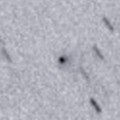
|
Now it is 16.5 mag (Jan. 17, Yasukazu Ikari). It tends to be brightest after the perihelion passage. It is observable in excellent condition in the Northern Hemisphere. It locates somewhat low in the Southern Hemisphere. It will be fainter than 18 mag in March.
Date(TT) R.A. (2000) Decl. Delta r Elong. m1 Best Time(A, h)
Feb. 11 11 6.43 29 40.0 1.852 2.773 154 17.2 1:46 (180, 25)
Feb. 18 11 0.11 30 38.2 1.877 2.813 157 17.3 1:12 (180, 24)
|
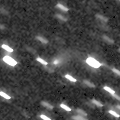
|
Now it is 16.3 mag (Jan. 17, Yasukazu Ikari), brighter than the early ephemeris. It keeps observable in good condition for a while after this. It keeps 17 mag until February.
Date(TT) R.A. (2000) Decl. Delta r Elong. m1 Best Time(A, h)
Feb. 11 7 21.55 1 2.3 1.530 2.402 144 17.2 21:57 (180, 54)
Feb. 18 7 19.95 1 31.5 1.587 2.416 138 17.3 21:28 (180, 53)
|
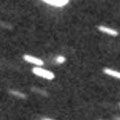
|
It keeps observable at 17 mag for a long time from 2011 to 2013. In 2012, it keeps observable in good condition until early September.
Date(TT) R.A. (2000) Decl. Delta r Elong. m1 Best Time(A, h)
Feb. 11 16 40.40 -0 24.8 5.855 5.666 74 17.4 3:56 (245, 31)
Feb. 18 16 39.08 0 2.8 5.727 5.660 81 17.3 4:05 (237, 38)
|
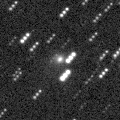
|
Although it has passed the perihelion in 2010 November, it is uxexpectedly bright as 16.5 mag still now (Jan. 16, J. Nicolas). It keeps observable in excellent condition for a while. It will keep 16-17 mag for a while after this.
Date(TT) R.A. (2000) Decl. Delta r Elong. m1 Best Time(A, h)
Feb. 11 5 34.25 12 28.1 4.616 5.200 121 17.3 20:31 (173, 42)
Feb. 18 5 30.80 13 19.0 4.772 5.250 113 17.5 20:21 (166, 41)
|
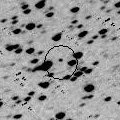
|
Peculiar asteroid moving along a cometary orbit. Now it is 17.4 mag (Jan. 4, Catalina Sky Survey). It keeps observable at 18 mag for a long time from 2008 to 2014.
Date(TT) R.A. (2000) Decl. Delta r Elong. m1 Best Time(A, h)
Feb. 11 7 20.13 16 27.6 5.817 6.669 147 17.3 21:56 (180, 39)
Feb. 18 7 15.90 17 11.4 5.896 6.676 139 17.4 21:24 (180, 38)
|
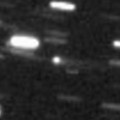
|
Now it is 17.4 mag (Jan. 18, P. C. Sherrod). It keeps observable at 18 mag for a long time until 2013.
Date(TT) R.A. (2000) Decl. Delta r Elong. m1 Best Time(A, h)
Feb. 11 5 0.53 25 20.6 3.398 3.919 115 17.5 20:31 (166, 28)
Feb. 18 5 1.92 25 17.9 3.495 3.920 108 17.6 20:21 (162, 27)
|

|
It was observed so bright as 9.4 mag in September (Sept. 22, Chris Wyatt). It is still bright and visible visually at 14.7 mag (Jan. 26, Jakub Cerny). However, the nuclear magnitude is already so faint as 18.8 mag (Jan. 17, E. Prosperi, et al.). It will be observable while fading gradually after this. In the Southern Hemisphere, further observations are very hard.
Date(TT) R.A. (2000) Decl. Delta r Elong. m1 Best Time(A, h)
Feb. 11 13 0.50 48 55.3 1.646 2.363 125 17.6 3:40 (180, 6)
Feb. 18 12 26.55 53 15.0 1.688 2.442 129 17.9 2:40 (180, 2)
|
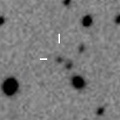
|
Now it is 17.2 mag (Jan. 14, K. Hills). It will brighten up to 13 mag in 2014. In 2012, it is observable at 17.5 mag in good condition in spring.
Date(TT) R.A. (2000) Decl. Delta r Elong. m1 Best Time(A, h)
Feb. 11 11 32.05 14 38.9 3.490 4.385 151 17.7 2:12 (180, 40)
Feb. 18 11 28.62 15 7.9 3.434 4.371 158 17.6 1:41 (180, 40)
|

|
It reached up to 15.3 mag in early summer in 2011 (June 19, Toshiyuki Takahashi). Now it is fading. It has already faded down to 17.5 mag (Jan. 16, K. Hills). It will be fainter than 18 mag in March. I will locate high in the Southern Hemishere, but somewhat low in the Northern Hemisphere after this.
Date(TT) R.A. (2000) Decl. Delta r Elong. m1 Best Time(A, h)
Feb. 11 16 1.39 -19 5.5 2.699 2.698 79 17.7 3:56 (257, 50)
Feb. 18 16 8.01 -19 47.9 2.633 2.727 84 17.7 4:05 (252, 57)
|
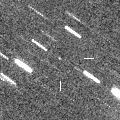
|
Now it is 19.2 mag (Nov. 21, W. Hasubick). It will bright rapidly after this, and will reach up to 16.5 mag from spring to summer. However, it locates extremely low in the Southern Hemisphere. In the Northern Hemisphere, it locates high now. But it will be getting lower gradually in the evening sky, and will be unobservable in June.
Date(TT) R.A. (2000) Decl. Delta r Elong. m1 Best Time(A, h)
Feb. 11 2 37.98 16 22.6 1.732 1.850 80 18.0 20:31 (129, 21)
Feb. 18 2 50.54 17 4.3 1.771 1.820 76 17.8 20:21 (129, 19)
|
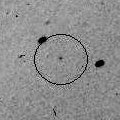
|
Peculiar asteroid moving along a cometary orbit. It was observed at 18 mag in 2010 autumn. It will be observable at 18 mag again in 2012 spring.
Date(TT) R.A. (2000) Decl. Delta r Elong. m1 Best Time(A, h)
Feb. 11 10 15.49 22 55.3 1.991 2.962 167 17.8 0:55 (180, 32)
Feb. 18 10 10.84 23 38.7 2.020 2.994 168 17.9 0:23 (180, 31)
|
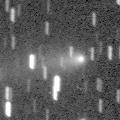
|
It had been fading after the perihelion passage in 2010 October, but it brightened again in outburst on Apr. 5, 2011. It reached up to 14.7 mag in May (May 28, Hidetaka Sato). It has been unobservable since July. But it is appearing in the morning sky now. Now it is 17.1 mag, much brighter than expected (Dec. 17, Ken-ichi Kadota). It locates low in the Southern Hemisphere. But in the Northern Hemisphere, it keeps observable in good condition after this. It will keep 17 mag for a while.
Date(TT) R.A. (2000) Decl. Delta r Elong. m1 Best Time(A, h)
Feb. 11 13 49.55 17 4.6 3.286 3.863 119 17.9 3:56 (190, 37)
Feb. 18 13 48.70 17 43.5 3.235 3.890 125 17.9 4:00 (180, 37)
|

|
It had expected to keep 17 mag for a long time from 2011 summer to 2012 spring and observable in good condition in the Southern Hemisphere. But actually, it has faded down to 20.7 mag (Jan. 16, D. Herald), much fainter than expected by 4 mag.
Date(TT) R.A. (2000) Decl. Delta r Elong. m1 Best Time(A, h)
Feb. 11 7 55.82 -62 38.1 1.908 2.304 100 20.3 22:30 ( 0, 63)
Feb. 18 7 37.77 -57 30.6 1.899 2.349 104 20.4 21:45 ( 0, 68)
|
|
![]()
 C/2011 W3 ( Lovejoy )
C/2011 W3 ( Lovejoy ) C/2010 S1 ( LINEAR )
C/2010 S1 ( LINEAR ) C/2011 R1 ( McNaught )
C/2011 R1 ( McNaught ) 255P/2011 Y1 ( Levy )
255P/2011 Y1 ( Levy ) 246P/2010 V2 ( NEAT )
246P/2010 V2 ( NEAT ) C/2011 UF305 ( LINEAR )
C/2011 UF305 ( LINEAR ) 49P/Arend-Rigaux
49P/Arend-Rigaux C/2011 O1 ( LINEAR )
C/2011 O1 ( LINEAR ) C/2011 L4 ( PanSTARRS )
C/2011 L4 ( PanSTARRS ) C/2011 S2 ( Kowalski )
C/2011 S2 ( Kowalski ) C/2012 A2 ( LINEAR )
C/2012 A2 ( LINEAR ) C/2011 J2 ( LINEAR )
C/2011 J2 ( LINEAR ) C/2005 L3 ( McNaught )
C/2005 L3 ( McNaught ) 164P/Christensen
164P/Christensen P/2011 W2 ( Rinner )
P/2011 W2 ( Rinner ) C/2010 R1 ( LINEAR )
C/2010 R1 ( LINEAR ) C/2010 FB87 ( WISE-Garradd )
C/2010 FB87 ( WISE-Garradd ) 2008 YB3
2008 YB3 244P/2010 Q1 ( Scotti )
244P/2010 Q1 ( Scotti ) C/2011 Q4 ( SWAN )
C/2011 Q4 ( SWAN ) 117P/Helin-Roman-Alu 1
117P/Helin-Roman-Alu 1 123P/West-Hartley
123P/West-Hartley 60P/Tsuchinshan 2
60P/Tsuchinshan 2 (306173) 2010 NK83
(306173) 2010 NK83 240P/2010 P1 ( NEAT )
240P/2010 P1 ( NEAT ) C/2011 L2 ( McNaught )
C/2011 L2 ( McNaught )![]()







































